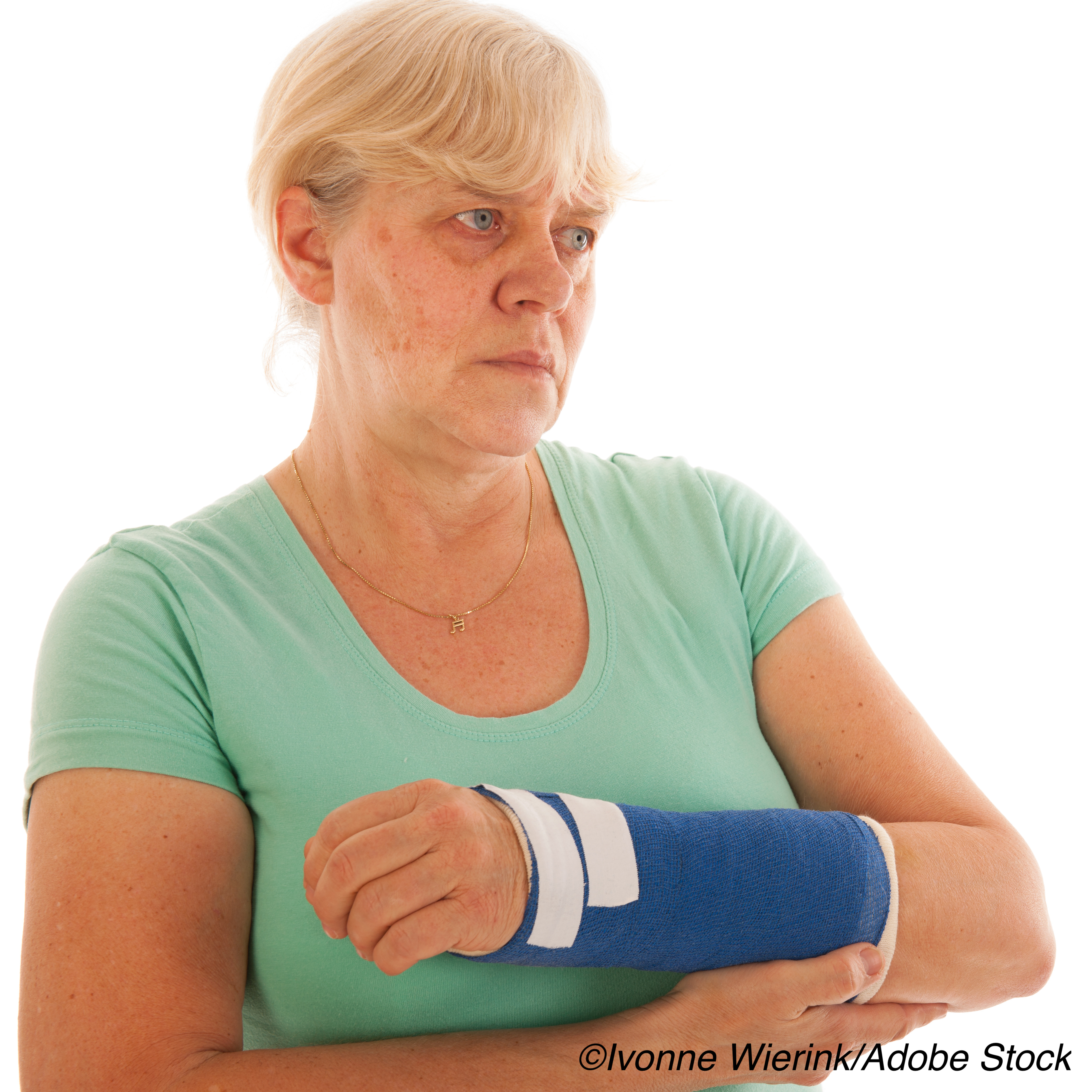Postmenopausal women over 50 who have suffered an initial fracture—whether traumatic or nontraumatic—are at increased risk of subsequent fracture, according to a recent study published in JAMA Internal Medicine. After both high- and low-trauma fractures, therefore, clinicians are urged to conduct assessments for osteoporosis.
“One in two postmenopausal women will have an osteoporosis-related fracture during their remaining lifetimes,” wrote Carolyn J. Crandall, MD, MS, FACP, of the David Geffen School of Medicine, University of California, Los Angeles, and fellow researchers.
“To our knowledge, no published studies have prospectively examined whether subsequent fracture risk differs according to whether an initial fracture is traumatic or nontraumatic among younger postmenopausal women in the US. A comparison of traumatic fractures and nontraumatic fractures in association with risk of subsequent fracture has the potential to affect clinical counseling and future clinical practice guidelines. The goal of this study was to determine how future fracture risk varies according to whether an initial fracture is traumatic or nontraumatic,” they added.
For this prospective, observational study, they used data from the Women’s Health Initiative Clinical Trials and WHI Bone Density Substudy—in postmenopausal women from 40 clinical centers in the U.S. ages 50 to 79 years—to identify 66,874 women (mean age: 63.1 years in those without fracture, and 65.3 in those with fracture) who reported fractures and their cause.
Compared with women who had not experienced a fracture, those who had were more likely to be White, experience one or more falls in the past year, and never use hormone therapy before study enrollment.
Women were followed for a mean of 8.1 years, during which 10.7% had an incident fracture. The risk of a subsequent fracture after initial fracture was 49% (adjusted HR [aHR]: 1.49; 95% CI: 1.38-1.61). Among those in whom the initial fracture was traumatic, the association between initial fracture and subsequent fracture increased significantly (aHR: 1.25; 95% CI: 1.06-1.48). In women in whom the initial fracture was not traumatic in nature, this association was also increased (aHR: 1.52; 95% CI: 1.37-1.68).
“This study’s findings suggest that all fractures, whether traumatic or nontraumatic, should warrant evaluation for osteoporosis (including BMD testing) and counseling regarding subsequent increased fracture risk. These results advance our understanding of the burden of potentially preventable fractures, which is higher in women with initial traumatic fractures as well as those with initial nontraumatic fractures. Fracture in postmenopausal women older than 50 years is associated with a greater risk of subsequent fracture, regardless of mechanism (traumatic or nontraumatic). This information will inform the development of targeted secondary prevention strategies and future clinical guidelines,” concluded Crandall and colleagues.
“In approaching a patient who has fractured a bone, clinicians are trained to detail the circumstances of the fracture. Was it the result of a ground-level fall or a higher level of trauma? We do this because we believe that the fracture sustained after minimal or no trauma constitutes a fragility fracture and that fragility fractures are the only ones that warrant evaluation and interventions to prevent future fracture. Clinical practice guidelines reinforce this behavior,” wrote Anne L. Schafer, MD, and Dolores M. Shoback, MD, both of the Endocrine Research Unit, San Francisco Veterans Affairs Health Care System, and the University of California, San Francisco, in an accompanying editorial.
But these results from Crandall et al counter this, and clinicians are urged to evaluate bone health in postmenopausal women who sustain any type of fracture.
“What evaluation and interventions may be warranted in the person with fracture, be it nontraumatic or traumatic?” queried Schafer and Shoback.
“Evaluation should include a thorough history with attention to other risk factors for skeletal fragility, individualized laboratory evaluation for secondary causes of osteoporosis, and bone density assessment when indicated,” they answered.
Interventions for those in need can include nutritional counseling, weight-bearing exercise, alcohol and smoking cessation counseling, and the avoidance of medications that carry detrimental effects on bone and skeletal health. Some patients may need pharmacologic therapy, the most common of which “have been shown to have similar effects on low-trauma and high-trauma nonvertebral fractures,” noted Schafer and Shoback.
“The idea that nontraumatic versus traumatic is a distinction without a difference will likely be welcomed by busy clinicians. What clinician would not appreciate being relieved of the tedium of trying to accurately interrogate a patient about the energy and impact of the fall, the step from which they fell, the softness or hardness of the surface for landing, the rung of the ladder on which they had been standing, or the speed the car had been moving?” they concluded.
Limitations of the study include its observational nature, the inclusion of only the first initial fracture at each anatomic location, and the exclusion of bone mineral density measurements in 37 of the WHI clinical centers.
-
Researchers found that in postmenopausal women who suffered a fracture, the risk for future fracture is similar whether the initial fracture was traumatic or nontraumatic.
-
Clinical assessments of osteoporosis in postmenopausal women should include both high- and low-trauma fractures.
Liz Meszaros, Deputy Managing Editor, BreakingMED™
The WHI program is funded by the National Heart, Lung, and Blood Institute, the National Institutes of Health, and the U.S. Department of Health and Human Services.
Crandall and Shoback reported no disclosures.
Schafer reports receiving investigator-initiated research grant funding from Amgen and is an author, without compensation, on a study sponsored by Radius Health.
Cat ID: 438
Topic ID: 437,438,282,494,438,730,191,334,255,158,925


